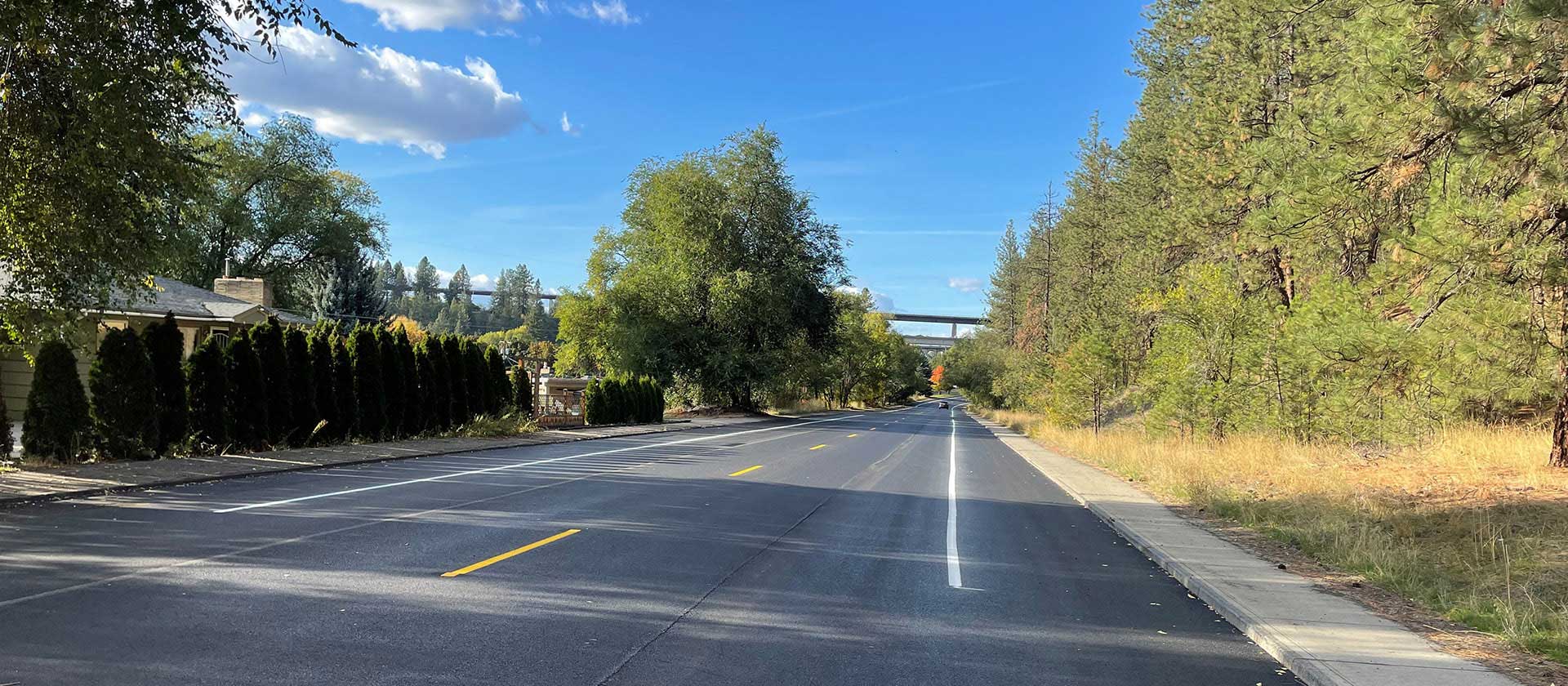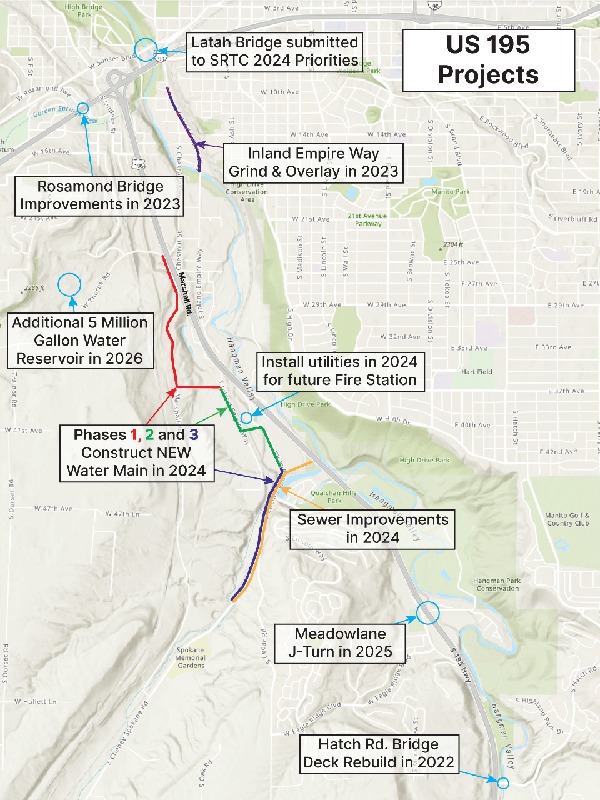
Progress on the US 195 Corridor
Kirstin Davis, Communications Manager, 509.625.7773
Tuesday, October 10, 2023 at 3:55 p.m.

Policy to Planning
Maybe you are turning north onto US 195 from the recently installed turn lane at Hatch Rd. or cautiously waiting to turn south on the highway from Thorpe Rd. Either way, you are probably aware of the challenges and improvements that have happened in the area.
The US 195 corridor stretching between Sunset Highway and Hatch Road has seen many changes as it continues to see increased activity and growth. Increased traffic and housing units being built are visible every day. Planning for growth and capacity is not as obvious.
We've all heard the phrase "there is no such thing as overnight success." Development takes a similar patience and perspective. Often, there are years of information gathering, evaluation, strategizing, funding acquisition, grant writing, stakeholder and public engagement, agency coordination, and project management before development ideas move to breaking ground.
The US 195 area is an example of the complexity of growth management. Jurisdictional overlaps, dynamics of the economy, population changes, and the demand for development impact how communities move forward.
When timelines are long, perspective is subject to change. With that in mind, here is an update for projects that are supporting the growth along US 195.
Moving Along
Funding for transportation improvement needed to support growth started back in 2008 when the Spokane City Council established the ability to charge development transportation impact fees that would help to address transportation needs and support future growth.
That work was updated in 2017 when the City formed the Transportation Impact Fee Advisory Committee to assist. Their work resulted in several modifications to the established code including a West Plains District, additional credits for bike and pedestrian-friendly development, an update to the fee structure, and a new improvement project list.
Staff worked with the Committee from Nov. 2022 through Jan. 2023 additional changes. Included was an updated project list largely from a US 195/I-90 study completed in 2021, a new impact fee centered on the Latah Valley, project cost estimates, and a rate schedule.
The US 195/I-90 studywas done by Spokane Regional Transportation Council in partnership with the City and WSDOT. Goals of the study included:
- Improving Safety
- Maintaining Mobility
- Accommodating Transportation Needs for Future Development
- Increasing Modal Options for Walking, Biking, and Transit
- Identifying Projects for a Reasonable Timeline: Practical, Implementable, Fundable
Read the entire study.
One of the transportation projects identified in that study already is moving forward. City of Spokane applied for and received a $1.6 million federal grant for the US 195 / Meadowlane J-Turn covering two-thirds of the cost of the project and development has committed the remaining $800,000 to the safety improvement. This is expected to be constructed as early as 2025 and will add a second J-Turn to the corridor along with one that was installed in 2019 at Thorpe Rd.
Meanwhile, more transportation work is progressing.
Spokane City Council recently approved a resolution for the Latah Bridge/High Bridge/Sunset Bridge that would improve access to the area. The resolution formally designates the bridge as a legislative priority for the City, making it eligible for submission to SRTC's 2024 Unified List of Regional Transportation Priorities. The projected cost of the project is $64.7 million. The City is working on a federal bridge grant proposal to acquire funding.

Funding has been awarded by WSDOT for an additional study on Inland Empire Way, which wasn't part of the US 195/I-90 study. This road adds important additional connectivity, but the City needs a better understanding of the projects needed to improve drivability and handle increased traffic. A contract for this study is currently being finalized.
While larger improvements clearly are needed, our Streets Department provided a great improvement this summer. Street crews completed a grind and overlay project on Inland Empire Way between 9th Ave. and Latah Creek that already is improving daily trips in the area.
Still, there's more. The City advocated for WSDOT to retain the Rosamond Ave. bridge and that bridge deck was rehabilitated this year by the state agency. This project supports the increased need for connectivity with the West Hills and Browne's Addition neighborhoods.
The City replaced the Hatch Road Bridge deck in 2022, improving the safety of the structure and adding a turn-lane to relieve congestion turning north onto US 195 from Hatch Rd. and improving connectivity in the area.

US 195 Phased Projects Map (PDF 535 KB)
Water in, Water Out
Along with transportation improvements, utility service projects are underway. The Marshall Rd. Transmission Main projects will increase water capacity in the area. The three-phased project is expected to be completed in the next two years. There is a plan to do sewer extension work as well in 2024.
Marshall Rd. Water Transmission Projects:
A request for bids is underway for a new 5 million-gallon water reservoir to be built adjacent to the existing Thorpe water tank. This will add more water capacity to the area by 2026.
The City is also working to move ahead on a new fire station in the area. Water and sewer connection for a station at a parcel owned by the Spokane Fire Department near Cheney-Spokane Rd. will be installed as part of other utility work in the area in 2024. This will make the lot shovel-ready for that station when design and construction dollars are available. When wildfires in this "wildland urban interface" area threatened, Public Works and Spokane Parks and Recreation worked together to prioritize water availability for firefighting over irrigation for the Creek at Qualchan golf course.
Checks and Balances
Development in any municipality takes time and requires planning along with several check-points. City of Spokane's development regulations provide consistent guidance to manage development in areas where public infrastructure is inadequate and there is demand for growth. City code establishes a test for transportation, public water, fire protection, police protection, parks and recreation, libraries, solid waste, schools, and wastewater.
In many ways, development and adequate infrastructure go hand-in-hand. Basically, infrastructure conditions are likely to improve because of new development, not in spite of it. Road networks are a good example. Connectivity through the Latah Valley and to the surrounding areas will be enhanced as new projects are built that add new connections and alternative routes, as required by City Code.
In all cases, community engagement is needed to provide valuable perspectives for future change.
More About...
- Browne’s Addition
- Building Opportunity and Choices for All
- Community
- Development
- Families
- Family
- Fire
- Grandview
- Highway
- Home
- Housing
- Housing Action Plan
- Housing Crisis
- Improvements
- Latah Valley
- Neighborhoods
- roads
- Safety
- Sewer
- Shaping Spokane Housing
- Spokane Fire
- Streets
- Thorpe
- Traffic
- US 195
- Water
- WSDOT
